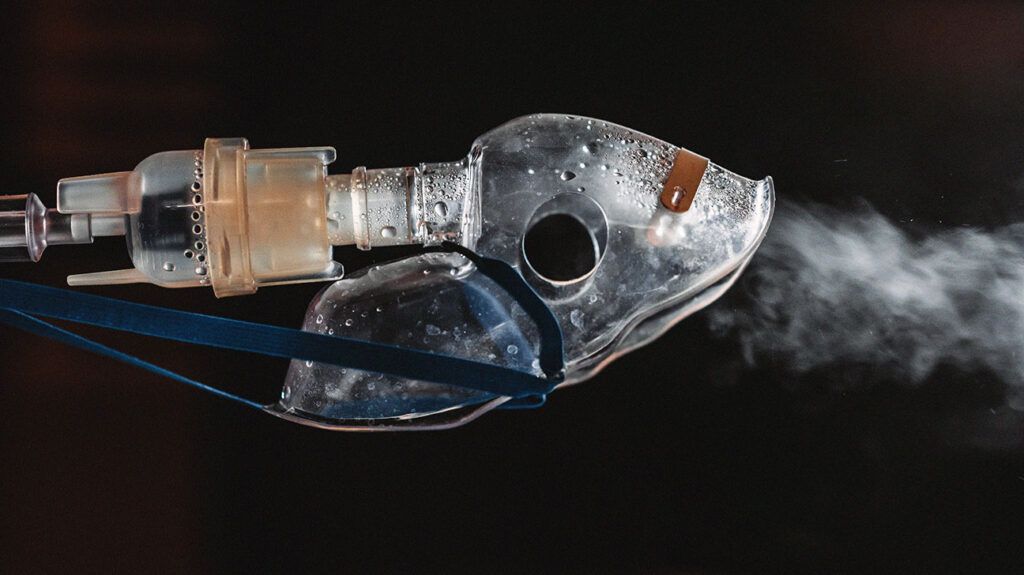A nebulizer is a piece of medical equipment that a person with asthma or another respiratory condition can use to administer medication directly and quickly to the lungs.
A nebulizer turns liquid medication into a very fine mist that a person can inhale through a face mask or mouthpiece. This method allows medication to go straight into the lungs and respiratory system, where it is needed.
This article looks at what a nebulizer is, who it is for, how to use it, and more.

Doctors typically prescribe nebulizers to people with one of the following lung disorders:
Sometimes, a doctor will prescribe a nebulizer for a child who has a respiratory infection, such as bronchiolitis.
Learn how to use a nebulizer for a baby.
Before a person starts taking medication with a nebulizer, a medical professional will explain how the nebulizer works and answer any questions.
If a person receives their nebulizer from a pharmacy or medical equipment company, someone there will explain how to use it.
Each nebulizing machine operates a little differently. It is crucial to read the instructions for the particular device that the doctor has prescribed.
In general, a nebulizer is very easy to use, with only a few basic steps:
- Wash the hands.
- Add the medication to the medication cup according to the doctor’s prescription.
- Assemble the top piece, tubing, mask, and mouthpiece.
- Attach the tubing to the machine according to the instructions.
- Turn the nebulizer on; they can be battery or electrically-powered.
- While using the nebulizer, hold the mouthpiece and medication cup upright to help deliver all the medication.
- Take slow, deep breaths through the mouthpiece and inhale all the medication.
Please speak with the doctor or call the manufacturer with any questions or concerns about the device.
Learn more about using a nebulizer at home.
Inhalers and nebulizers deliver medication into the lungs. However, there are some important differences.
A nebulizer is an electric machine that converts liquid medication into a fine mist. It is attached to a tube and a mouthpiece or mask. A person inhales the mist through this and into the lungs.
An inhaler is a small, handheld device that allows a person to breathe in medication as a spray.
Learn more about the different types of inhalers.
The American Lung Association (ALA) recommends washing a nebulizer after every use, including the mouthpiece or mask, top piece, and medication cup.
A healthcare professional or pharmacist will demonstrate how to clean and maintain the device. The general guidelines are as follows:
- Wash your hands and work on a clean surface.
- Disconnect the tube, medication chamber, mask, or mouthpiece and wash thoroughly in warm, soapy water or a dishwasher.
- Rinse and allow the pieces to air dry.
It is essential to follow the manufacturer’s instructions for cleaning, disinfecting, and replacement. Most compressors have an air filter that a person will need to replace every 6 months or so.
If a person does not take good care of a nebulizer, it can become contaminated by bacteria that can cause an infection. Infections can be very dangerous, particularly for a person with a lung disorder.
This section answers some frequently asked questions about nebulizers.
What does a nebulizer do for you?
A nebulizer is a medical device that turns liquid medication into a very fine mist that a person can inhale through a face mask or mouthpiece.
Taking medication this way allows it to go straight into the lungs and respiratory system.
Do I need a prescription for a nebulizer?
Yes — typically, a nebulizer and the medication it uses require a prescription from a doctor or another healthcare professional.
It is possible to purchase a nebulizer machine online without a prescription, though a doctor will probably still need to prescribe the medication.
However, some medication manufacturers require the use of a specific type of nebulizer, so it is always a good idea to double-check with the pharmacist or doctor before making a purchase.
There are several types of medication that a person can use with a nebulizer:
- Bronchodilators: These are drugs that help open the airways and make breathing easier. Doctors often prescribe bronchodilators to people with asthma, COPD, or other respiratory disorders.
- Sterile saline solution: A nebulizer can deliver sterile saline to help open the airways and thin secretions. This may loosen mucus in the lungs, making it easier to cough up.
- Antibiotics: A nebulizer can deliver some types of antibiotics straight into the lungs or respiratory tract when someone has a severe respiratory infection.
Does a nebulizer help with cough?
Yes, nebulizers can help with a cough, depending on a person’s medication and condition.
Doctors typically prescribe nebulizers to people with lung disorders such as asthma, COPD, cystic fibrosis, and bronchiectasis.
Medications such as bronchodilators can help open the airways and make breathing easier, potentially alleviating a cough for someone with certain lung disorders.
A nebulizer can also deliver some types of antibiotics into the respiratory tract if someone has a severe respiratory infection. This can help treat the infection and clear up the symptoms, such as coughing.
A nebulizer is a piece of medical equipment that delivers medication directly to the lungs and respiratory system, where it is needed.
While the device is simple to operate, it is essential to use, clean, and maintain it correctly. Make sure to consult the manufacturer’s manual, a pharmacist, or a healthcare professional with any questions or concerns.
